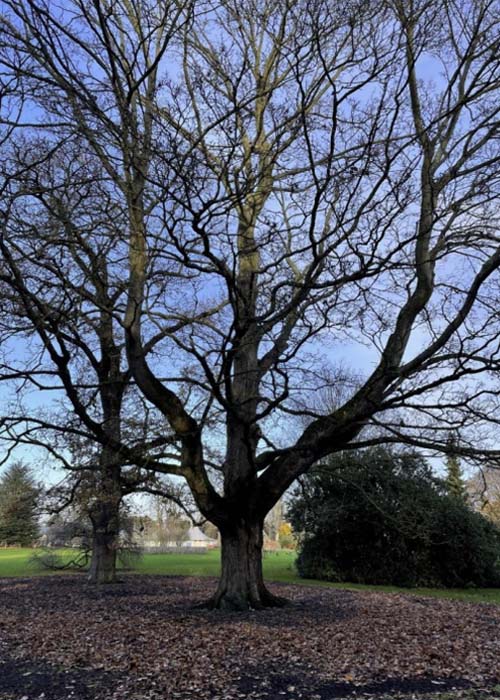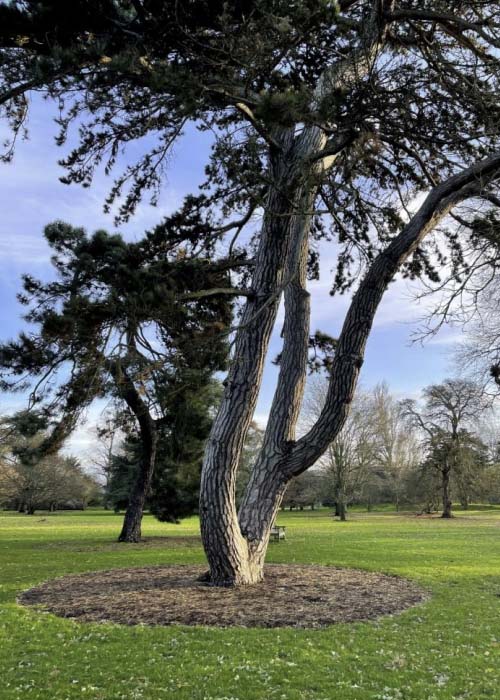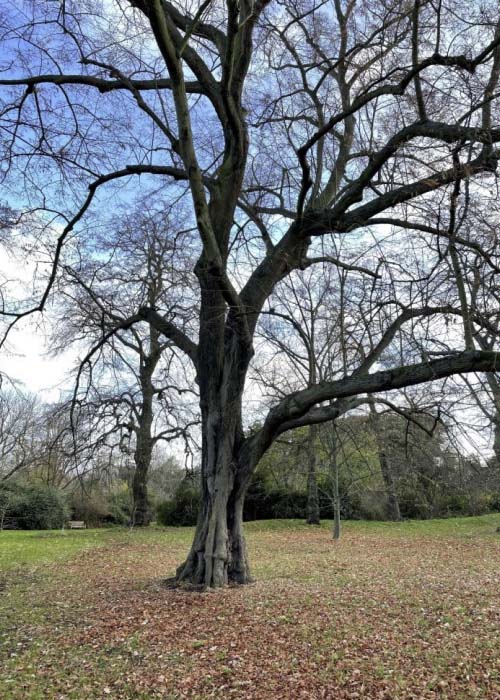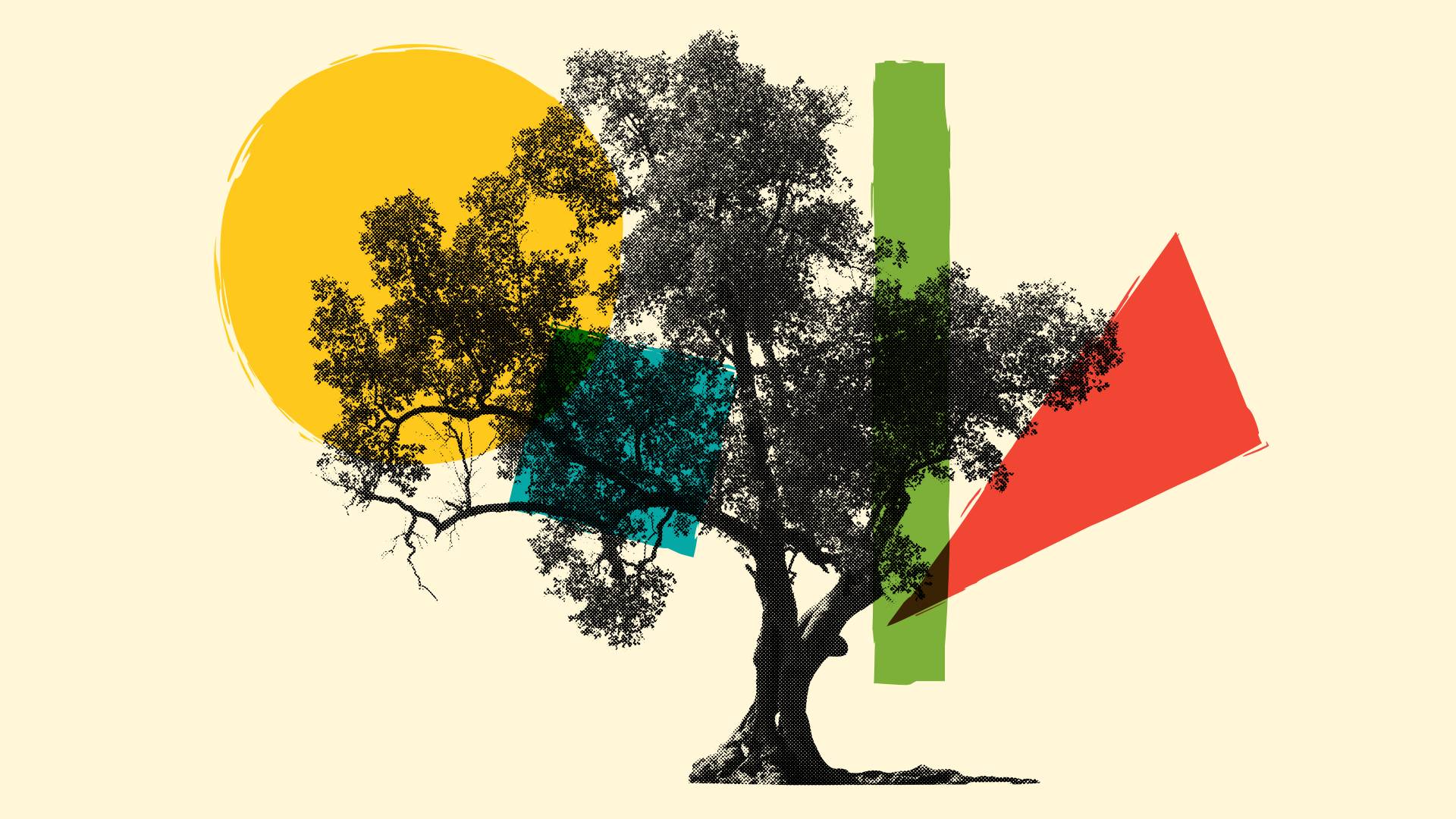
Treehouses
Design Competition
‘Treehouses’ will be a spectacular outdoor architectural exhibition of seven treehouses set across Kew Gardens’ iconic 320-acre landscape. We are delighted to announce the winners and share the shortlisted entries.
The level of work that all of the shortlisted practices have put into the second stage is incredible. The attention to the narrative, the science links and the design was impressive, but we could only take three forward. I can not wait to see the three that have been chosen as they all have a strong link to the brief and are very different in approach and technique.“
Melissa Woolford, Founder and Director of Museum of Architecture
WINNERS
Norway Maple tree: Celebrating play
Polypore/Play that Fungi Music
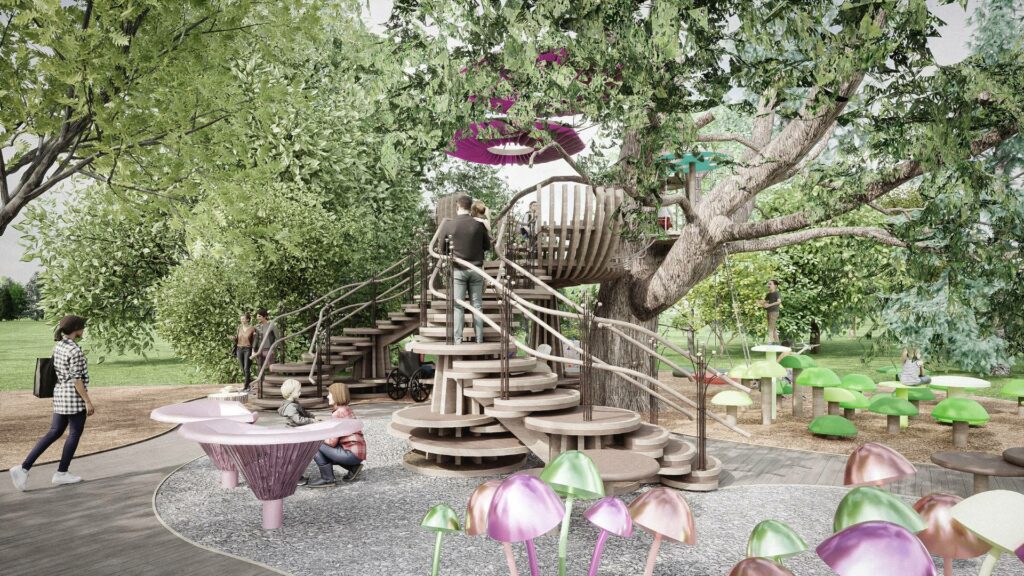
Team: India Aspin & Amy Jenkins Smith


An ode to fungi, this treehouse strives to highlight Kew’s world renowned expertise in fungi research and aims to celebrate the beauty and wonder of fungi. Knowingly referencing the role of mushrooms in popular culture, it unashamedly plays with both scale and colour.
As a play space, this treehouse aims to be accessible to all. The cascading polypore inspired steps of the treehouse create a tactile and accessible covered ground level space for those unable to venture further. Those able to use stairs are rewarded with the fungi inspired tree top platforms, one with full height standing space and a second, kids den, with limited headroom.
Surrounding the tree, creating a sensory play landscape there are a range of interactive play mushrooms, some for climbing & jumping and others of a more musical nature, each element inspired by a different fungi species.
Pine tree: Highlighting nature’s
architecture and biomimicry
An Audience with Nature
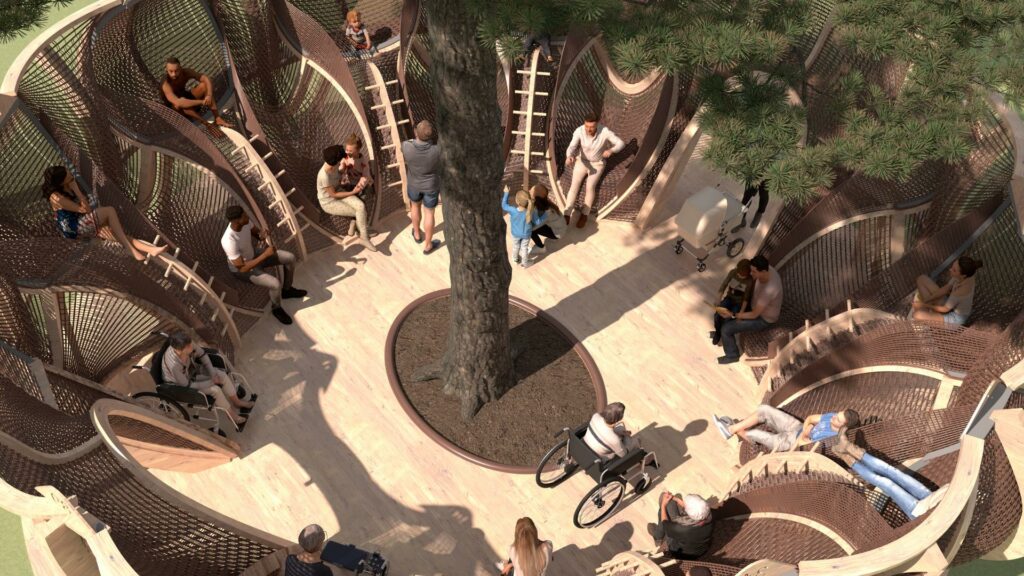
Team: Kevin Kelly Architects with Stand
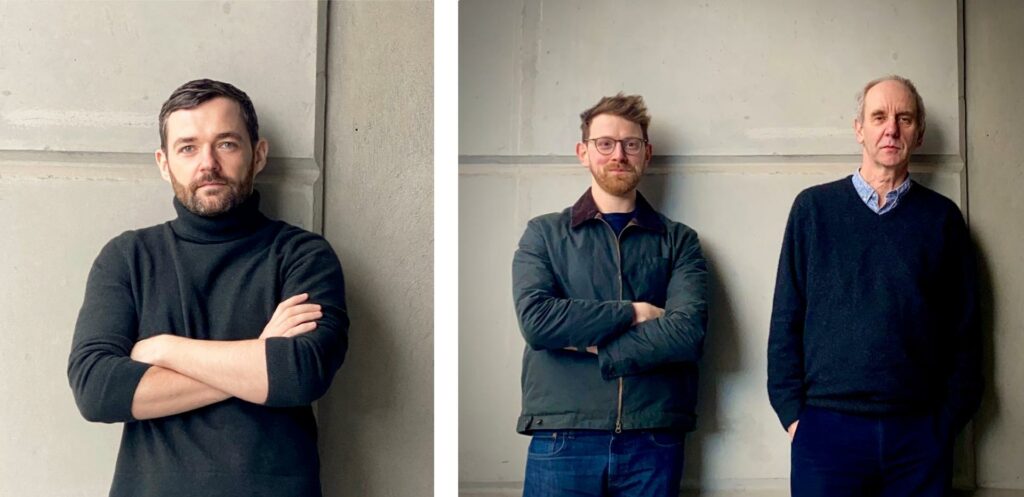
Using principles borrowed from nature, our treehouse is an inhabitable amphitheater. Mimicking pinecones, the structural strength of the pods comes from their shape and their arrangement as a cluster. Organized over two tiers, for those who want to keep their feet on the ground or the climbers amongst us. It is a space to sit down and look up, to witness the greatest designer of them all, nature.
We looked beyond the traditional idea of a ‘Treehouse’ to provide a fresh interpretation of what it can be. We wanted to capture the childhood intimacy offered by treehouses or a den made from cushions: a hinterland, concealed away but yet neither inside or outside – somehow inhabiting a threshold.
We used digital programming as part of our design process and applied it to a centuries old construction technique and material. This re-frames willow weaving and elevates it beyond the realm of craft to contemporary architectural discourse. Our woven willow is choreographed into digital patterns inspired by Kew’s research into the DNA and genome sequences of conifer trees.
Silver Lime tree: Showcasing the use of
sustainable materials and innovative designs
Linden Thing
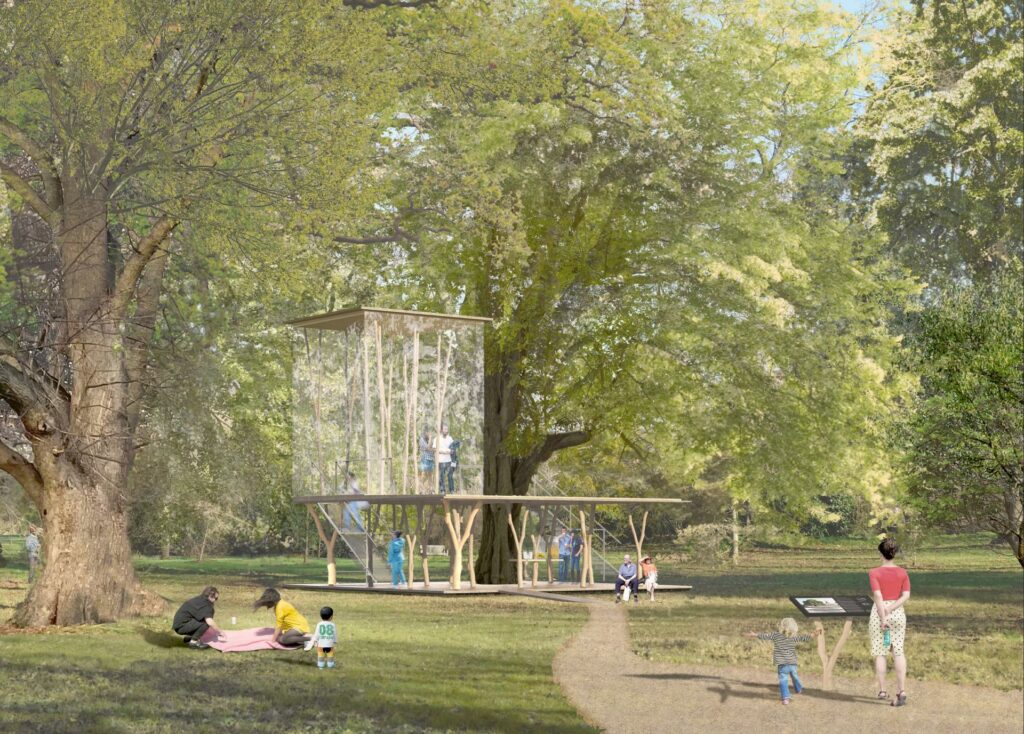
Team: Patrick Fryer + Thomas Randall-Page + Xylotek

Linden – of the lime tree
Thing – an assembly or assemblage, a coming together of parts
Both teahouse and treehouse, Linden Thing is a place of assembly for refreshment, contemplation and conversation.
Inspired by the Germanic Gerichtslinde, a linden tree where historically assemblies were held in order to restore justice and peace. Communities would gather under a lime tree to hold their meetings. It was believed that the linden tree would help unearth the truth.
The Linden Thing seeks to heighten the visitor’s appreciation of this spectacular Silver Lime; its majestic sculptural trunk, the sublime dappled light of its canopy and the heady aroma of Lime Flower Tea which will be offered inside.
We propose carefully selecting and harvesting forked branches in the forest, to create a grid of ‘Y’ shaped columns. These will support the delicate CLT slabs whilst bracing the structure, a synergy of low and high timber technologies.
The Kew Treehouses project is an excellent initiative and I was struck by the quality of submissions for the long list. The design teams diligence, imagination and drive made the process of finding three winners both hugely enjoyable and challenging. I very much look forward to walking, sitting, climbing and relaxing in the treehouses next year.
India Aspin and Amy Jenkins Smith’s entry is a delightful proposition that explores fungi at the scale of architecture, object and form in a delightful and playful way. Patrick Fryer, Thomas Randall-Page and Xylotek’s treehouse will be a striking Pavilion that moves from the architectonic to the primitive in a sophisticated and engaging dialogue with the Linden tree all enjoyed whilst sipping Linden tea. Kevin Kelly Architects with Stand’s amphitheatre like, architecturally scaled, furniture will offer a place to relax and reflect under the canopy of their tree.”
Simon Allford, Executive Director, Allford Hall Monaghan Morris
It has been absolutely fascinating to see how each team has approached the brief. There were, of course, some similarities, but there was enough variation to make it really exciting as a judge. The process of choosing the winners was really intriguing to see. We all came up with a similar thought process of what we liked and the outcome is what we wanted.”
Artist and designer Morag Myerscough
THE SHORTLIST
Norway Maple tree: Celebrating play
MushRoom EarthRoom
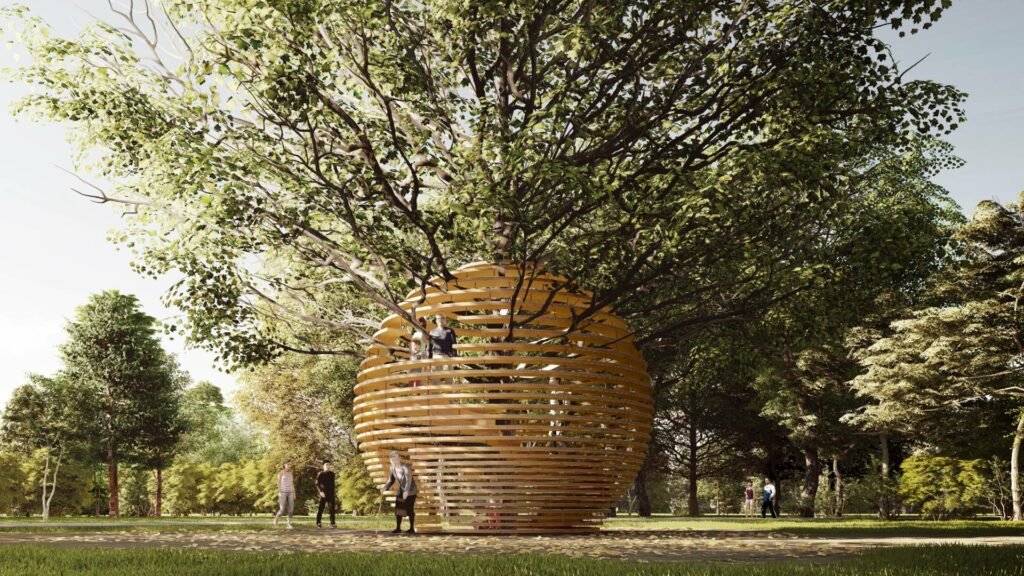
Team: Tonkin Liu with
Sam Clark, founder, Moro
Gary Grant, ecologist, Green Infrastructure Company
Martin Bailey, forager, Go Foraging
Tom Baxter, founder, Bristol Fungarium

Symbiosis between plants and fungi is the most important interaction to life on earth. Tree 1, a Norway Maple coming to the end of its life, is a prime example of the many complex interactions that take place between fungi and plants, from the mycorrhiza beneath the ground and bracket fungus growing up its trunk, to the lichen and leaf rust visible on its branches and leaves.
Mush Room Earth Room celebrates its end of life and regeneration, towards the creation of diverse new lives. A CLT ecosphere harnesses the weather and natural elements, creating a gradient of environments for visitors to explore planted fungal species, from the dark and sheltered to the bright and breezy.
Dappled light, scent, texture, and sound of earth, tree, and fungi, are
captured and amplified. A fanning stair raises the visitor through the strata of planted fungal species planted within its layers.
Treetop Playscape
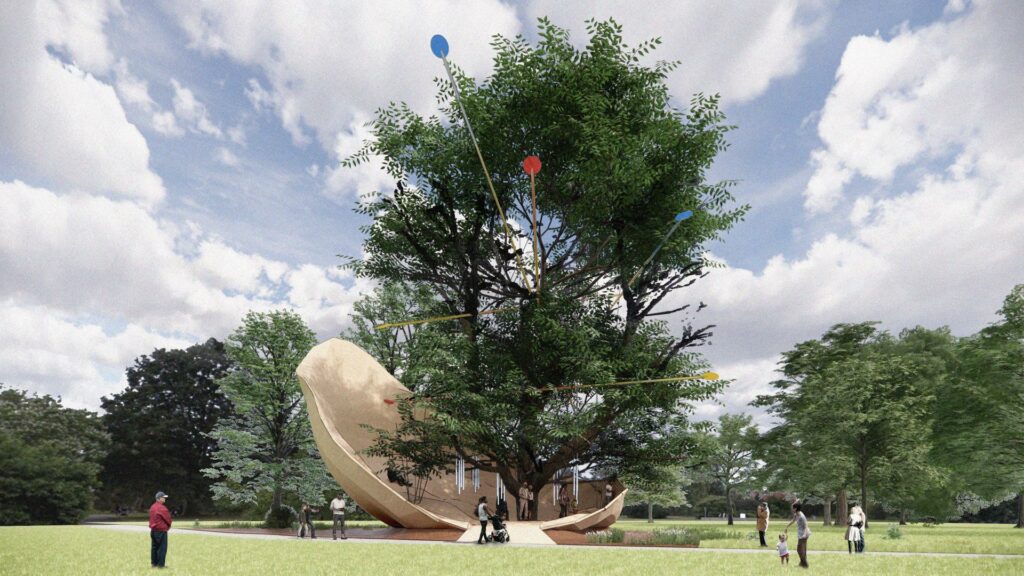
Team: Unknown Works
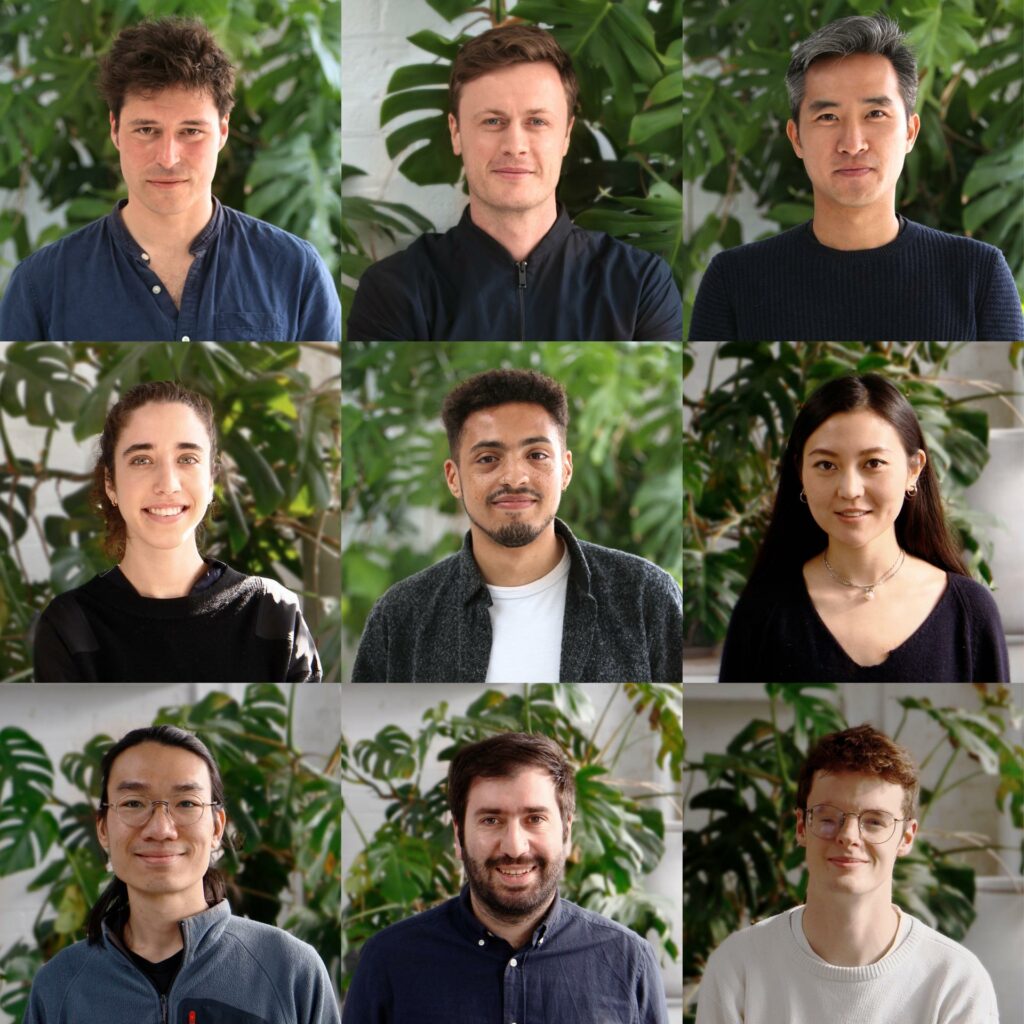
A treehouse is an otherworldly place, a realm of separation from the hum-drum everyday of the ground below. Treetop Playscape, a proposal by design and architecture studio Unknown Works, celebrates and amplifies play amongst the treetops.
The shell is borne straight from the host Norwegian Maple itself; a direct offset of its silhouette, cracked open. The inside surface is a soft and gently inclined tree topography of triangular CLT panels, encouraging climbing, sitting, exploration upwards as well as sliding downwards. The minutiae of life in the tree becomes framed, a stage for play.
A set of Amplifiers nestled amongst the tree branches amplify play between the four protagonists; Tree, Human, Animal and the Elements. Each instrument tackles a different sense. A squirrel jumps on to an Amplifier; that swoops and rustles branches on the other side of the tree, exciting a parakeet and a child who giggles, putting a smile on everyone’s face!
We are delighted to have chosen three winners from the incredible ten shortlisted entries to our Treehouses Competition. We at Kew are passionate about the role art and architecture can play in communicating complex stories around the important role plants and fungi play in supporting all life on earth. The winning designs demonstrate a unique approach, using sustainable materials, to offer personal connections and experiences with the trees they surround and inhabit. We cannot wait to see the impressive treehouses being realised within Kew Gardens among our collection of precious trees. It’s going to be the must-see exhibition in London for 2023 I have no doubt.“
Paul Denton, Head of Visitor Programmes and Exhibitions, RBG Kew
Pine tree: Highlighting nature’s
architecture and biomimicry
Finghi
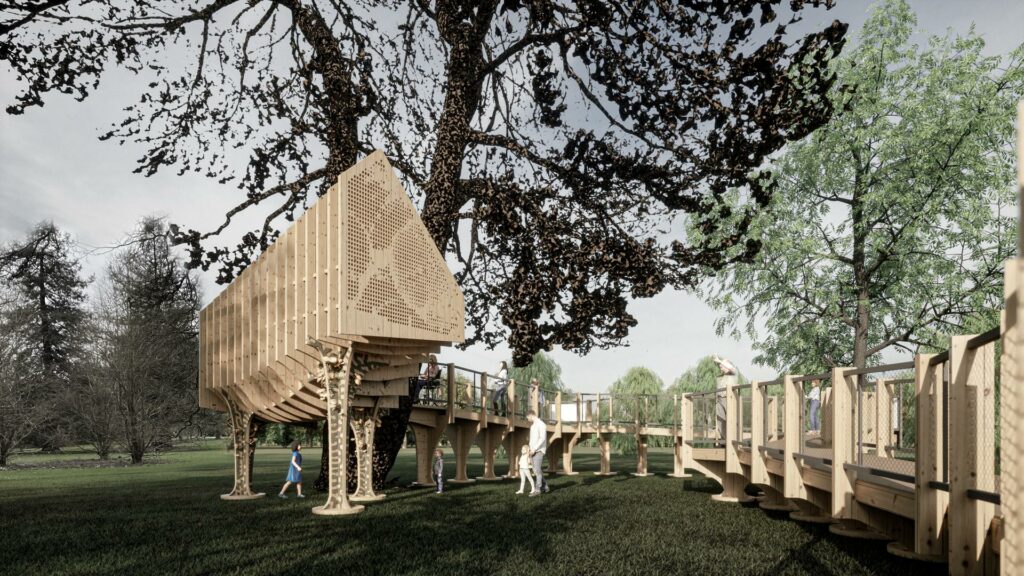
Team: Studio John Bridge

The concept of our treehouse is inspired by nature’s growing cycle and how organics can influence a vernacular treehouse form. The treehouse and ramp access references cellular patterns within Mycelium. The structure connects arbitrary forms found in nature and mimics trunks of trees that support the ‘canopy’. CLT pine ribs are cut by a CNC process, creating cascading asymmetrical ribbed elements. The end facades are perforated, creating a nature inspired design.
The ramp’s form represents molecular compounds, creating an interactive experience with node landings. Following a gradual elevational rise, guests arrive at their destination between the Kew’s Black Pine Tree trunks. Here, the user is immersed by the sculpted form. Up-cycled fishing nets infill the rib sections. Below the treehouse you see and interact with Fungi. The columns host Mycelium plugged sheaths that add to the educational experience for visitors of Kew Gardens.
The Nest
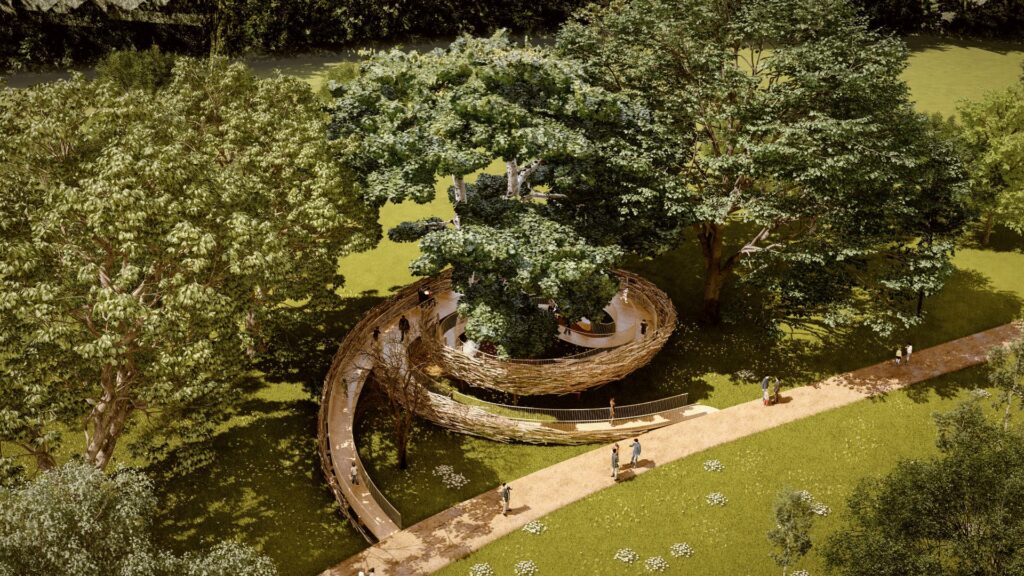
Team: Ignacio Garcia Donoso and Sabela Rey Vila

At its heart, this project is an analysis of nature, its structures, systems and processes. As such, it is also a reflection on the interaction between society and its natural environment.
The proposal aims to provide a unique experience, accessible for all, that will attract new visitors to Kew Gardens by creating an engaging walkable canopy into and around the tree.
The Nest takes one on a journey of discovery. Rising from the garden floor, the first impression is of the tree being wrapped by an organic element, raising one’s curiosity to discover what lies hidden within. Further up the gentle slope into this organic element, the branches of adjacent trees mark one’s progress, until the cladding vanishes to reveal the spectacular central tree whose very branches the path now bisects.
The design of the project is inspired by structures made by birds in particular cup-shaped nests. These structures in the natural environment variously combine materials such as twigs, moss and dried leaves – creating surprisingly strong curves, from angular and weak source materials. With The Nest, we mimic these natural textiles found in nature, by using multiple pieces of wood positioned in an organic and aleatory way, with a directional shape to guide the visitor.
It was a real privilege to be part of the judging panel for this competition. In some cases it was really hard to choose one design over another. The entrants had really considered how we connect with trees, how can we interact with them and how can we view the trees in a different way. The competition is a breath of fresh air, a much needed project that connects us with our surroundings. It is important to think about how we connect to nature. Trees are the grandparents of nature. To understand nature we’ve got to understand trees and the treehouses help us do that.”
Property expert and broadcaster, Kunle Barker
Silver Lime tree: Showcasing the use of
sustainable materials and innovative designs
A Tower of Trees
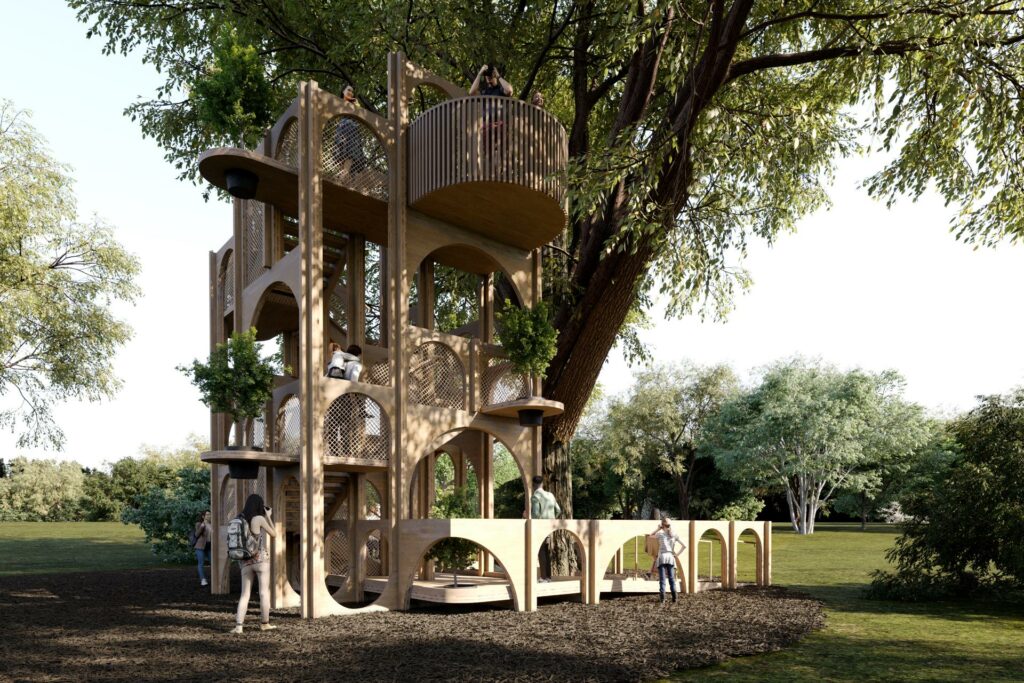
Team: Agenda Architecture

Adjoining a large silver lime tree located towards the eastern edge of Kew Gardens, this proposal explores the elevated experience typically associated with a treehouse. It also spotlights the tenuous relationship between the built environment and the natural resources required to construct it.
Ten saplings scattered among the towering structure represent the number of mature trees harvested to amass the volume of wood needed to build this entirely cross-laminated timber (CLT) treehouse. Typically deployed in solid walls and slabs, CLT blanks cut into a system of columns and arches result in a lighter structure that references the filigree nature of the iconic Palm House of Kew Gardens.
The modular components allow the tree house to be disassembled and rebuilt elsewhere. However, at the end of its life, we envision turning it into mulch and planting the trees to symbolize the replacement of resources used to make this treehouse possible.
Bower to the People
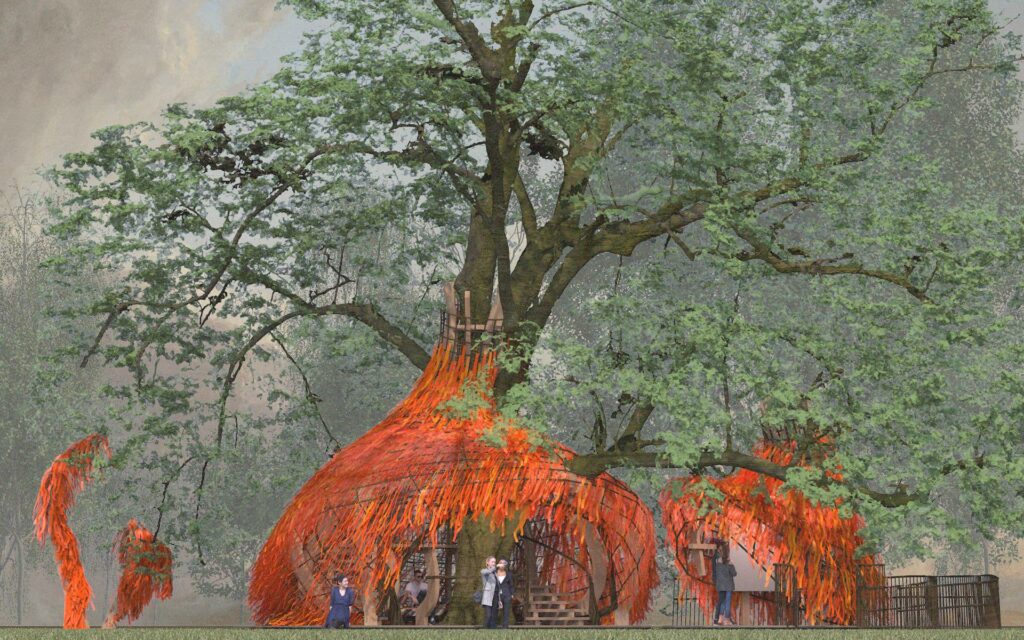
Team: Built Works

Although widely recyclable, the majority of used plastic exists in its original state. This plastic blows across landscapes, washes up on beaches, or finds itself incorporated in bowers and nests of animals. 100kg of recycled polyethylene offcuts has woven themselves into two bowers under a Black Pine in the gardens at Kew.
Tactile willow handrails lead visitors to the shady relief of the enclosing bowers of this beautiful tree – regardless of impairment guests can see, listen, and feel their way around this seemingly natural structure and shelter, heartbreakingly contaminated by discarded plastic. The brightly coloured straps rustle in the breeze, clinging to the willow frame. The conical form creates an intimate space to be shared with the Black Pine, where an understanding can be reached regarding habitat and shelter.
The Outdoor Room
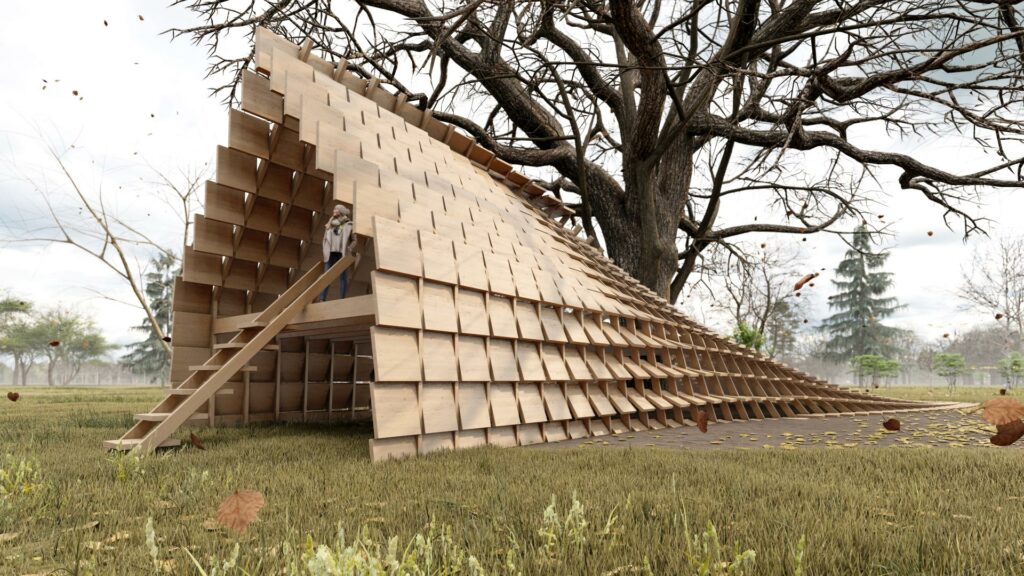
Team: NUDES
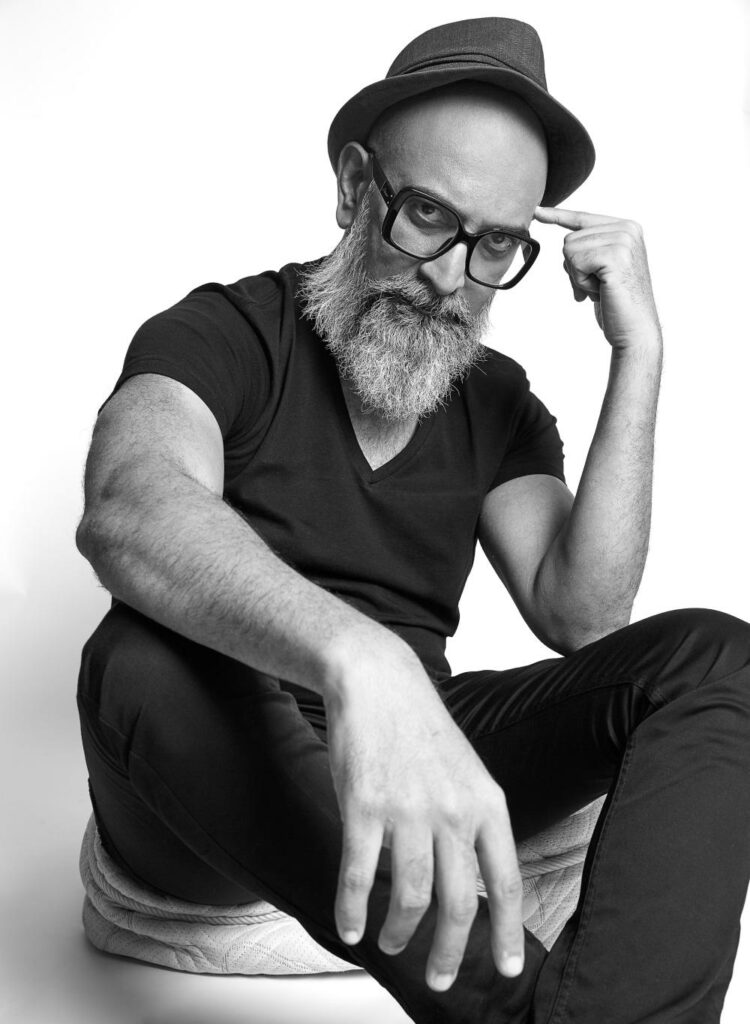
“The Outdoor Room” explores the inter-relationship between ”tree,” “house,” and “landscape” to create a unique design experience inspired by nature, driven by technology. The project rises from the landscape to morph into a treehouse profile creating a unique figure-ground relationship. The existing tree, landscape, and treehouse are woven together as a unified construct that enables varied experiences respecting the site and surrounding context.
The “Outdoor Room” is an inside-outside experience that can be accessed by all age groups and aims at creating a sense of “place” and “recreation” for the visitors. Horizontal platforms are defined for access, seating, reading, and meditation. These platforms aggregate, proliferate and rotate differentially to morph from landscape into skin. The space is accessible via ramps, platforms and a climbing ladder, offering a sense of intrigue, adventure, and curiosity. The project is “light-footed,” fabricated in Cross Laminated Timber CLT, advocating sustainability, respect for the climate and the earth’s resources.
“The Outdoor Room” treehouse aims to celebrate life and blur the boundaries between figure-ground, house-landscape, and humans-nature.
It was amazing to see how each of the design teams rose to the challenge of meeting the accessibility brief through very diverse approaches from a birds nest ramp spiralling around a pine tree, an accessible dwelling immersed in the tree canopy which played with dappled light and the sound of rustling leaves to a garden filled with sensory-rich magical musical mushrooms.”
Jayne Earnscliffe, inclusive design consultant to the project and Director of Earnscliffe, Making Access Work
About the Treehouses at Kew Design Competition
Royal Botanic Gardens, Kew is a world-leading plant science institute and UNESCO World Heritage Site and are pleased to be partnering with the Museum of Architecture to create this inspiring project. Treehouses at Kew will be Kew’s main exhibition running from April to October 2023 and provide one of the most enticing and unmissable visitor experiences in the 2023 London cultural calendar.
This impressive project will include seven Treehouses, a gallery exhibition, and an accompanying visitor programme.
Treehouse 1: Celebrating play
Videos of Tree 1
Treehouse 2: Highlighting nature’s architecture and biomimicry
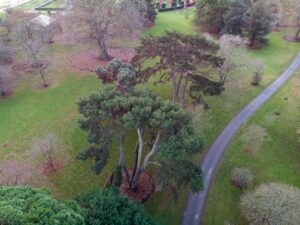

Video of Tree 2
Treehouse 3: Showcasing pioneering sustainable materials and innovative design
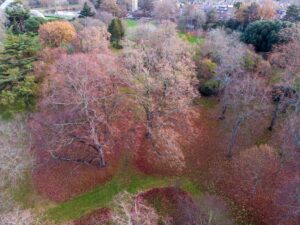


Video of Tree 3


Official Provider to Treehouses
Arup is the anticipated Official Provider to Treehouses

